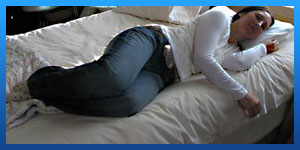How to Sit With a Fractured Vertebrae
An important part of your recovery is to learn how to perform safe movement techniques, done in a way that doesn’t put additional strain on the spine. This includes sitting down and getting up from a chair, especially if you need to work behind a desk. Here are the important steps on how to sit with a fractured vertebrae:
- Start by Understanding Neutral Spine Position
The first and most important step to perform day-to-day activities after a vertebral fracture is to understand a neutral spine. First, understand that there are 24 bones altogether. Each bone has different shapes and sizes.
A neutral spine is when each of these 24 bones are perfectly aligned and are stacked on top of the other, forming three gentle natural curves that create a strong support post for the head. This perfect alignment is the strongest and safest position for the spine, giving you the foundation to sit in better comfort.
PRO TIP: Even when your spine is neutral and a movement is done correctly, some movements may be painful, especially during the early stages of recovery. Although it may be painful in the beginning to get into the neutral spine position because of your stiff back muscles, it is the best position to protect your spine.

Read more about : Knee replacement surgery cost(Zimmer brand)
- Use the Right Kind of Chair
Most chairs do not always accommodate your specific needs for spinal support. In an effort to keep the spine neutral, while allowing the back muscles to relax, use the best ergonomic office chair. These chairs are expertly designed to support your spine and is the best investment you can make to work in ultimate comfort.
It doesn’t matter how well you sit. At the end of the day, you can’t find proper spine alignment if you don’t have the right furniture. A poorly designed chair can force you to sit in an awkward position and slouch, causing unnecessary strain on your back and hindering your recovery from a fractured vertebrae.
Read more about : femoral hernia recovery
Read more about : Best way to sleep with compression fracture
Read more about : Leg pain after varicose vein surgery
Read more about : How long do you have pain after knee replacement surgery?
- Sit by Imagining Balancing a Book on Your Head
To sit down in your chair, keep your head high and imagine that you are balancing a book on your head as you lower yourself to the edge of the seat. Once you perch yourself on the edge of the seat, stay upright and slide to the back of the chair slowly.
Once you are seated, it’s very important to keep the spine neutral at all times. One excellent way to do this is to use an ergonomic back support to keep the spine tall, while keeping it relaxed at the same time. You can also use a folded towel and place it on the lumbar (lower back) area of the chair.
Similarly, standing up from a sitting position can be a challenge as it puts a huge strain on the spine. Most people have the tendency to round the spine when standing from a chair. Therefore, it’s paramount to train your muscles to stand up from a sitting position with your head held high to minimize spinal strain.
- Wear a Back Brace and Apply Ice
Additionally, wearing an ergonomic back brace during the first few weeks following a fractured vertebrae can help keep your spine upright, reducing the work your muscles have to do. Not only does it help reduce the discomfort, but it ensures that your movement around the fracture is careful and fully controlled.
Another excellent home care tip is to apply an ice pack over the injured area for 15 to 20 minutes every 3 to 6 hours. It’s a good idea to do this for the first 24 to 48 hours. You can start with ice to reduce inflammation, then switch to heat after 2 days to treat muscle spasms.
- Be Diligent With Physical Therapy
Once the fracture has healed, your trained healthcare professional will recommend exercises to strengthen the muscles that support your spine. If you want to achieve better results when recovering from a fractured vertebrae, then it’s important to follow the program given by your physical therapist diligently.
Don't sit for long periods of time. This puts more stress on the lower back than standing or walking. A great way to start is by taking a break once every 30 minutes of sitting. Set a timer to remind yourself to vary your posture, stand up, and reduce stress on your back. You can then slowly increase the time you spend walking.
PRO TIP: Some people find relief from pain by using reclining chairs with a high back and lumbar support. If you are unable to sleep at night, you can occasionally try sleeping in a reclining armchair.
Read more about: Femoral Hernia vs Inguinal Hernia
Bottom Line
Learning how to sit correctly with a fractured vertebrae will help you heal and prevent re-injury in the future. While your body may have been able to tolerate bad posture habits before the injury, you need to apply new good habits so you can perform day-to-day activities like you used to, after the spine fracture.
Start by investing in the right chair, practicing the proper methods for sitting, and maintaining correct posture throughout your day. Additionally, you can also use ergonomic cushions or wear a back brace for additional support. If the pain continues, talk to your healthcare provider about other ways to manage your pain.
About Iranian Surgery
Iranian surgery is an online medical tourism platform where you can find the best Surgeons in Iran. The price of a Compression Fractures Treatment in Iran can vary according to each individual’s case and will be determined based on photos and an in-person assessment with the doctor.
For more information about the cost of Compression Fractures Treatment in Iran and to schedule an appointment in advance, you can contact Iranian Surgery consultants via WhatsApp number 0098 901 929 0946. This service is completely free.
The best way to sleep with a compression fracture
Manage pain during sleep:
. Do not sleep on a waterbed. Waterbeds do not provide good back support.
. Sleep on a firm mattress. You may also put a ½ to 1-inch piece of plywood between the mattress and box spring.
. Sleep on your back with a pillow under your knees. This will decrease pressure on your back. You may also sleep on your side with 1 or both of your knees bent and a pillow between them. It may also be helpful to sleep on your stomach with a pillow under you at waist level.



4 Comments
My injury is a week ago. Too late for ice?
Hello. As you did not mention how your injury happened and how severe it is these are some general information that might help you. First, yes, it’s too late for ice. Second, the most common cause of a compression fracture is excruciating falls from a height. A serious injury in a car accident or other accident can also lead to a broken back and spine. If you have a compression fracture in your spine, there are several main goals you should persue in your treatment: your pain should go away, the fracture should heal, and the osteoporosis that weakens your bones and, as a result, breaks them down, should be treated. In compression fracture chances are that you will not need surgery. Most patients can be treated without one. Compression fracture usually heal on their own in about three months. Whether you have surgery or not, you will usually need a brace or medical belt for 8 to 12 weeks. After this period, you should do physiotherapy treatment for six weeks. You can often reduce your pain by taking anti-inflammatory drugs such as ibuprofen or acetaminophen.
I’m suffering from a L3 and L4 compression fracture, torn left rotator cuff, and bruised ribs on my right side from a MVC. The injury has caused numbness and weakness of my left upper arm, making it a bit more difficult to get comfortable. I was given a cortisone injection by my dr to get me through week two as I wait for an appointment with a neurologist.
Hello. Your situation is complex and can not be analyzed within a comment. We need scans and full history, please contact our consultants via WhatsApp to help you in a better way.